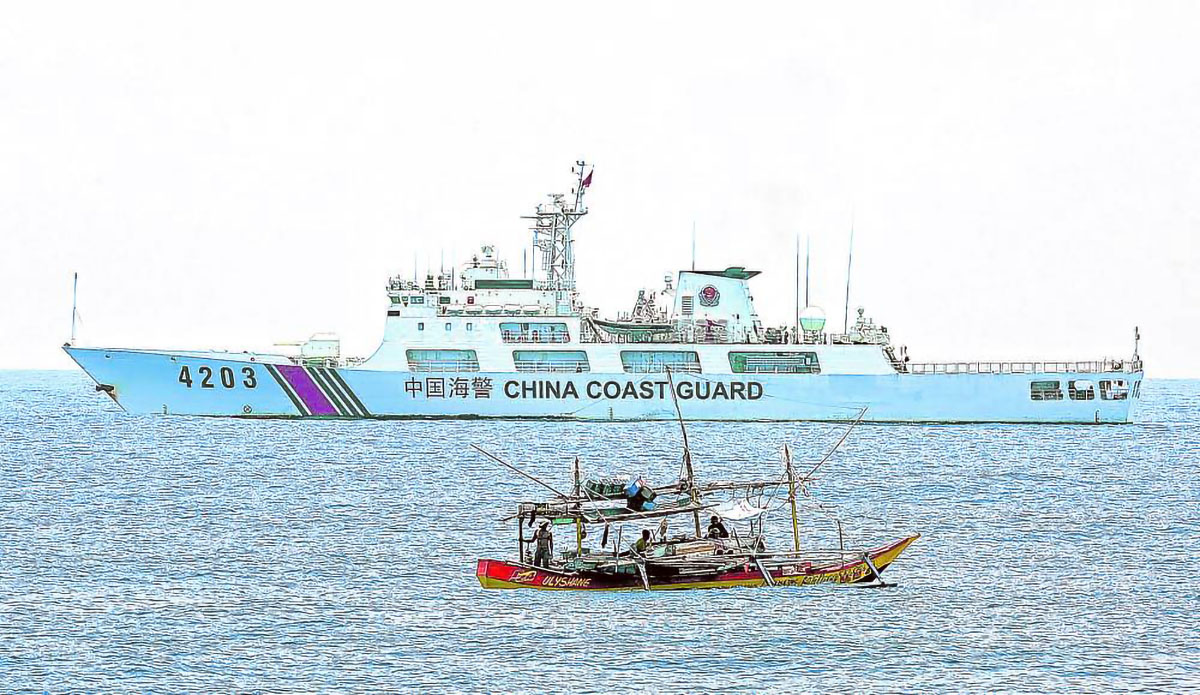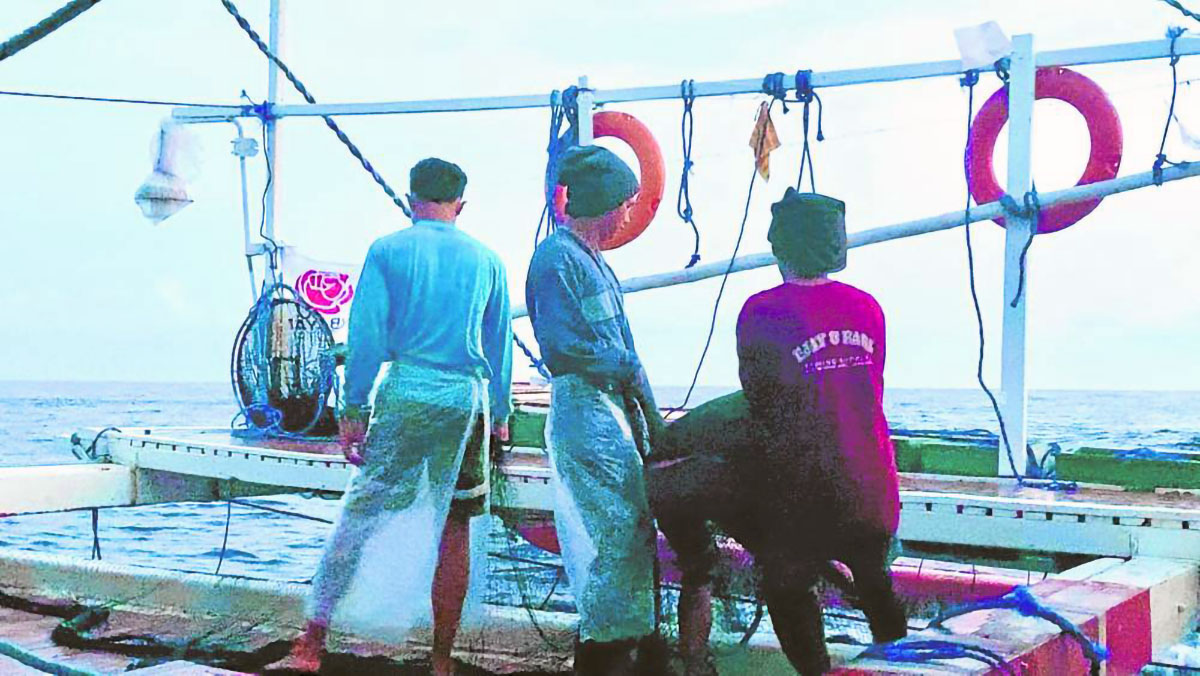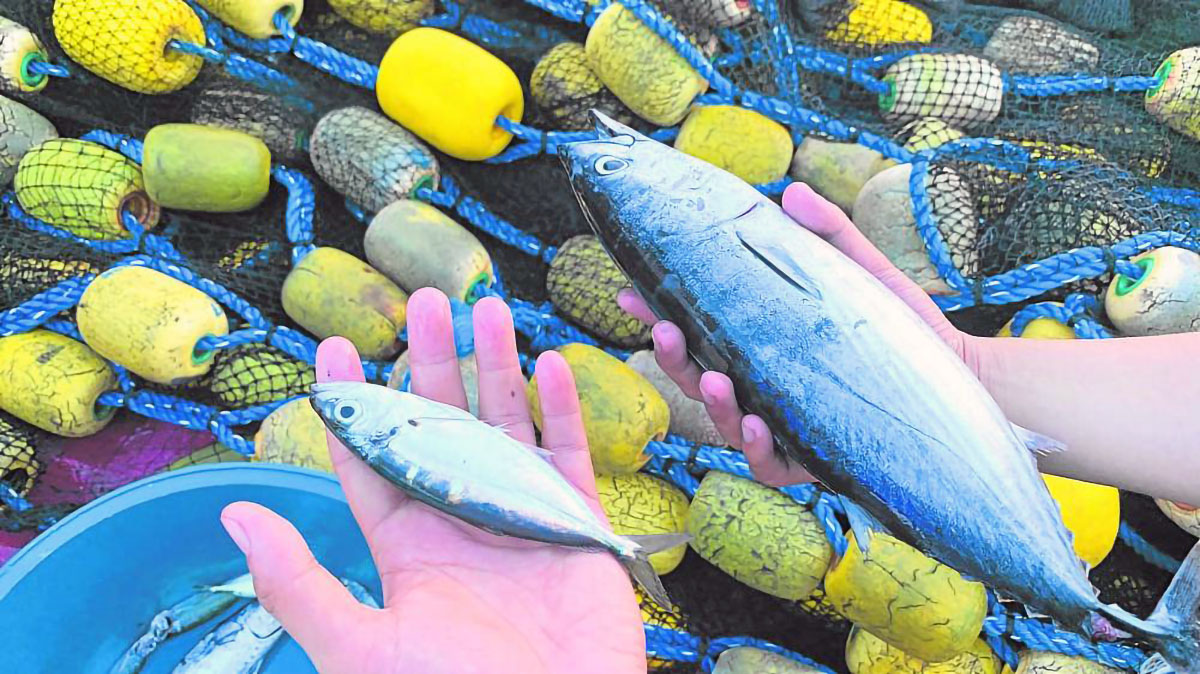Zambales fishers face troubled waters

TAKING RISKS Among the dangers that Zambales fishers have to hurdle in the open sea is the increasing presence of China Coast Guard vessels patrolling the Scarborough Shoal, also called Panatag or Bajo de Masinloc, in the West Philippine Sea. —photo by Richard Reyes
MASINLOC, ZAMBALES, Philippines — The predawn stillness in this town’s shoreline is usually broken by the familiar noise made by fishermen going about as they prepare their small wooden boats to sail into the sea amid a backdrop of an early morning mist.
Among this group is 31-year-old Joseph Dulem, a fisherman since his early teens. His calloused hands reveal the years of hard work that he has dedicated to a life at sea.
As a small-scale fisherman, Dulem practices traditional fishing, primarily using hook-and-line methods that ensure they only catch fish of a healthy size.
“But we managed to make ends meet little by little, even though we didn’t go far,” Dulem told the Inquirer in an interview on May 29.
Dulem also serves as a “Bantay Dagat” or sea patrol volunteer, working to prevent illegal fishing activities within community marine sanctuaries and fighting illegal, unreported, and unregulated (IUU) fishing, which poses a significant threat to marine life.
Article continues after this advertisementREAD: Scarborough Shoal trips continue for Zambales fisherfolk amid tension in WPS
Article continues after this advertisement“The problem now is that there are too many commercial fishing boats nearby. Because the owners have permits, they [use big nets]. Local fishermen note that larger fishing vessels using industrial methods [displace] traditional fishermen,” said Dulem.These vessels employ gear that catch even juvenile species.
Experts warned that the use of such active fishing gear and other destructive practices leads to a significant decline in the ecosystem’s ability to sustain fish populations.
Rina Rosales, a natural resources management specialist at the United States Agency for International Development’s Sustainable Interventions for Biodiversity, Oceans and Landscapes, emphasized the need for intense fisheries management to address this imbalance.
“It can be a combination of things. First of all, destructive activities such as dynamite and cyanide fishing, or [the use of] active fishing gear, such as trawls and purse seines, should stop. Those are [those] who fish in the high seas, and if it goes inside [the municipal waters], it destroys habitats and the current [population] of fish… there,” said Rosales.

The Chinese incursion has left local fishermen with no choice but to stay away from the shoal and instead harvest fish from their “payao,” a fish aggregating device. —photo by Joanna Rose Aglibot
Interconnection
The current situation in Panatag (Scarborough) Shoal in the West Philippine Sea, she said, also affects the inland waters.
Aside from actively destroying the coral reef and the seabed, mining, the extraction of sand and the building of islands are among the factors that affect the health of the ocean, she said.
“Because it’s one whole ecosystem, they’re all connected somehow. There is connectivity; they all rely on each other and are not separate populations. So, if you’re destroying the habitats in the high seas, for sure, there’s a chain reaction,” said Rosales.
The impact of what is happening in the shoal, she said, is not limited to those who are venturing into the high seas but also affect small-scale fishermen who rely heavily on municipal waters for their livelihood.
The shoal, also known as Bajo de Masinloc to locals, used to be a rich fishing ground and served as shelter from storms for Filipino and foreign fishers in the West Philippine Sea.
But it has been off-limits and patrolled by Chinese vessels since 2012 as part of its supposed historic claim over most of the entire South China Sea.
In July 2016, the claim was junked by the Permanent Court of Arbitration (PCA) in The Hague in favor of the Philippines, but the Duterte administration had set the decision aside in favor of bilateral talks with Beijing.
Some fishermen in Zambales who used to venture into the shoal were not able to go back after experiencing harassment and intimidation by the China Coast Guard.
“What is happening is that they are retreating because they can no longer fish in the high seas. That even creates more pressure on already depleted fisheries. So you’re not solving the poverty there,” said Rosales.

Experts have also observed a dwindling fish population in the high seas, forcing local fishermen to catch even juvenile fish, such as skipjack tuna and torpedo scad, using meshed nets just to bring food to the table. —photo by Joanna Rose Aglibot
Noticeable changes
Fishermen who were able to return to the shoal noticed the changes happening there.
According to them, they need to spend more days at sea nowadays, which means spending more money on fuel and other supplies for each fishing trip just to bring home a decent catch.
Miguel Betana, who still ventures into the shoal, observed that coral reefs were destroyed because of destructive activities by the Chinese, such as cyanide fishing to catch live fish.
“They have equipment they use for sucking a mixture in a bucket. Some of my companions found some before, but I don’t know where they are now; it’s like a syringe. They pour the liquid onto the corals to catch more fish,” recalled Betana.
“The corals turn white when cyanide is used on them, and it takes a long time for them to grow back. We see it happening, but there’s nothing we can do. At least they have their coast guard watching over them; we don’t,” he added.
Gov’t aid
During a hearing held in this town last month by the House of Representatives’ committee on national defense and security and the special committee on the West Philippine Sea, lawmakers discussed the impact on local fishermen of Chinese incursions into the shoal.
Gov. Hermogenes Ebdane Jr. said that aside from safe access to traditional fishing grounds, local fishermen should be able to acquire bigger boats and better fishing equipment, and, in the face of the security problem, find alternative areas where they could continue to fish safely.
The provincial government, Ebdane said, has short- and long-term programs in place to address fisherfoks’ needs, and has set the stage for sustainable fishing by putting up funds for fisherfolk to go into “payao” fishing, a system that uses fish aggregating devices in the open sea.
“We’re laying the foundation to ensure development and progress for the next generation of fishers,” he said, adding that the long-term program starts with reorganizing fisherfolk into cooperatives to qualify for financing, followed by training and apprenticeship to ensure that they are ready to undertake the project.
Ebdane said the provincial government was teaming up with local educational institutions, including the Philippine Merchant Marine Academy, to train the youth in new fishing technologies, as well as fishing boat operations, to provide “a better foundation” for the fisherfolk.
A recent survey, he said, indicated that 65 fishermen’s groups have been organized in the province, with about 4,500 members.
“They can already get a big fishing boat for P1.5 million, and we can provide that at no interest,” Ebdane said.
“[But] there is really a big problem when our fishermen cannot access Bajo de Masinloc,” the governor said. “Worse, if they remain doing marginal fishing, then they become a problem to local government units because we have to dole out food or cash assistance every time they cannot go out to fish.”
Rest to regenerate
However, experts believe that giving fishermen bigger boats and extra gear does not guarantee that they will catch fish.
“The sea needs to rest. In other words, we need to allow fish to regenerate on their own, and even coral reefs, and seagrass beds, we need to allow them to regenerate on their own because, as much as possible, we want nature to heal on its own,” said Rosales.
She said that allowing natural biological processes to take place would be the best way “because we can’t control all the factors. So it needs to rest, in the sense of really stopping the destruction, or if we can reduce the fishing effort, reduce it.”
Using payao, she said, is also not a good method because it is just a fish aggregating device that simulates a coral reef.
“That’s not a natural structure to put under water, so it’s attracting all kinds of fish, even small ones,” she said.
A fish catch monitoring study in Masinloc showed that most of the catch now are juveniles. It only means that the fish was removed even before it spawned and regenerated.
“So that’s the problem with juvenile catch, and most of the catch today in many parts of the country is purely juvenile,” said Rosales.
One of the recommendations of experts to solve the declining fish catch is to limit fishing efforts or some seasonal closure to have some breathing space for the fish to regenerate.
“The thinking is still, the fish will never run out, when in fact, it’s down. We’re really in trouble. The Philippines is in trouble with fisheries because there are no more fish; they are running out. So that’s the first consideration: let’s multiply the fish first,” Rosales said.
For comprehensive coverage, in-depth analysis, visit our special page for West Philippine Sea updates. Stay informed with articles, videos, and expert opinions.